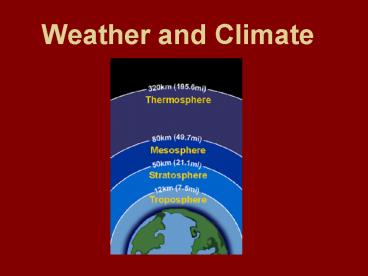Weather and Climate - PowerPoint PPT Presentation
1 / 18
Title:
Weather and Climate
Description:
Weather and Climate. Atomosphere ~ 78% N2, 21% O2, and other trace gases ... http://www.classzone.com/books/earth_science/terc/content ... weather of ... – PowerPoint PPT presentation
Number of Views:146
Avg rating:3.0/5.0
Title: Weather and Climate
1
Weather and Climate
2
Atomosphere
- 78 N2, 21 O2, and other trace gases
- composed of many layers
3
- troposphere
- lowermost and densest layer where clouds, wind,
and precipitation occur - gets colder with increasing altitude
4
- however, a temperature inversion can occur when
colder air gets trapped under warm air
5
- stratosphere
- next layer with very little water vapor
- gets hotter with increasing altitude
- at the top is the ozone layer (O3)which absorbs
much of the suns dangerous UV radiation
6
At 1,149 feet, the Stratosphere Tower is the
tallest freestanding observation tower in the
United States and the tallest building west of
the Mississippi River (not really in the
Stratosphere in case you werent paying
attention).
7
- mesosphere
- temperature decreases with altitude (coldest in
the earths atmosphere) - thermosphere
- temperature is high because the sun hits it first
- space shuttle orbits in here
8
- ionosphere
- an area within the thermosphere and mesosphere
- charged atoms reflect radio waves back to earth
9
Atomspheric Pressure
- the pressure that results from the column of air
above us - at sea level the air above you exerts a pressure
of 10.1 N/cm2 - this is about one ton of weight on (and all
around) your body!
10
(No Transcript)
11
(No Transcript)
12
- a barometer is a machine that measures how much
pressure the air is pushing down with - a rise in pressure usually means improving
weather while falling pressure usually means bad
weather
13
Wind
- air moves from an area of high pressure to low
pressure - this is down a pressure gradient that results in
wind - the Coriolis effect explains how the direction of
the wind is influenced by the earths rotation. - the earth moves faster at the equator than at the
poles
14
http//www.classzone.com/books/earth_science/terc/
content/visualizations/es1904/es1904page01.cfm?cha
pter_novisualization
- In the Northern Hemisphere winds move clockwise
- in the Southern Hemisphere, winds move counter
clockwise
15
(No Transcript)
16
Earths Climate
- the average weather of an area
- tends to be hotter at the equator because the
suns energy is perpendicular to the earth and
therefore more concentrated
17
- earths seasons are caused by the tilt (23.5º) of
the earth on its axis - the pole tilted towards the sun is hotter and the
days longer
18
(No Transcript)































